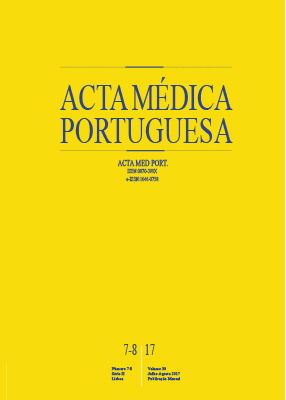Assessment of Urinary Incontinence in Pregnancy and Postpartum: Observational Study
DOI:
https://doi.org/10.20344/amp.7371Keywords:
Postpartum Period, Pregnancy, Pregnancy Complications, Urinary IncontinenceAbstract
Introduction: The urinary incontinence can affect up to 50% of women at some stage of their lives, particularly during pregnancy and postpartum. This study was designed in order to identify and assess the prevalence and risk factors for urinary incontinence during the third trimester of pregnancy and three months postpartum.
Material and Methods: Observational and cross-sectional study. The population of the study was composed of 268 women who delivered and were admitted to the Centro Hospitalar Tâmega e Sousa in the years 2013 and 2014, and who agreed to participate in this study. Postpartum women were asked to fill out a questionnaire adapted from the International Consultation on Incontinence Questionnaire - Short Form, for urinary incontinence research in the third trimester of pregnancy. Three months after delivery, they were contacted by telephone and asked to answer the same questions about the urinary incontinence postpartum.
Results: Of the 268 women interviewed, 31 were excluded from the study, taking into account the defined inclusion and exclusion criteria. In total (n = 237), 51.89% of women included in the study, reported the occurrence of urinary incontinence during pregnancy. The prevalence of urinary incontinence in pregnancy by parity (primiparous versus multiparous) was statistically significant (p = 0.006). At postpartum (n = 237), 28.69% of women with urinary incontinence had vaginal delivery and 5.91% of women underwent cesarean delivery (p = 0.001). In these group of women with postpartum urinary incontinence (n = 82), 31.69% have had urinary incontinence only in the postpartum and 68.31% of women have had symptoms during pregnancy (p < 0.001).
Discussion: This study demonstrates the high prevalence of urinary incontinence in pregnancy and the respective decrease in postpartum.
Conclusion: Multiparity and occurrence of urinary incontinence in pregnancy appear as potential risk factors in the emergence of the urinary incontinence.
Downloads
Downloads
Published
How to Cite
Issue
Section
License
All the articles published in the AMP are open access and comply with the requirements of funding agencies or academic institutions. The AMP is governed by the terms of the Creative Commons ‘Attribution – Non-Commercial Use - (CC-BY-NC)’ license, regarding the use by third parties.
It is the author’s responsibility to obtain approval for the reproduction of figures, tables, etc. from other publications.
Upon acceptance of an article for publication, the authors will be asked to complete the ICMJE “Copyright Liability and Copyright Sharing Statement “(http://www.actamedicaportuguesa.com/info/AMP-NormasPublicacao.pdf) and the “Declaration of Potential Conflicts of Interest” (http:// www.icmje.org/conflicts-of-interest). An e-mail will be sent to the corresponding author to acknowledge receipt of the manuscript.
After publication, the authors are authorised to make their articles available in repositories of their institutions of origin, as long as they always mention where they were published and according to the Creative Commons license.









